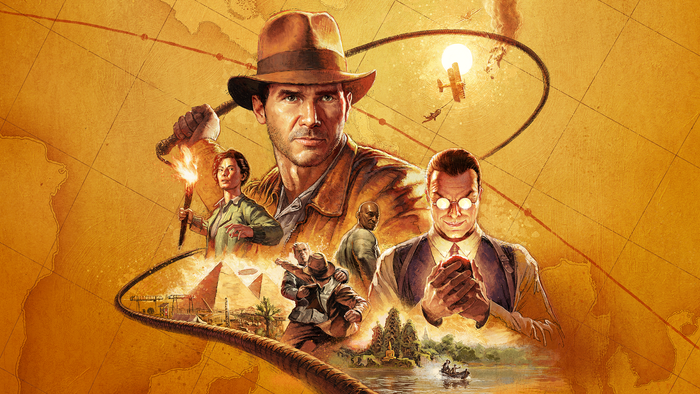Come Back: Dear Esther's devs and walking simulators 9 years on
The new Dear Esther: Landmark Edition, which features a commentary track recorded by key team members at The Chinese Room, is a great opportunity to reflect on this 2007 game's legacy.

As I sipped my scotch and played through The Chinese Room’s Dear Esther: Landmark Edition, I had to reflect on where we’ve been since 2007 and those halcyon days when Esther was still a Half Life 2 mod. Playing through this definitive release, available for the first time on XBox One and PS4, it’s hard not to reflect on the whole burgeoning genre of “walking simulators” and what they learned from this pathbreaking epistle of a game.
Clearly it was on the minds of the developers as well.
Writer Dan Pinchbeck, Composer Jessica Curry, and Artist Rob Briscoe were reunited for the first time in many years to provide developer's commentary for the Landmark Edition, with audio snippets spread throughout the island that you activate by walking through them. Many focused on the environmental storytelling of the game and are worth a listen for any game developer.
The emergent theme, which says so much about the nature of this slow-paced, ethereal game--and, indeed the whole "walking simulator" genre--grows out of Pinchbeck's assertion that "the player's imagination is the most powerful thing you've got in your design kit." Such games compel the developer to reach into the mind of the player like never before.

Jessica Curry, Rob Briscoe, and Dan Pinchbeck recording commentary
Esther: A Ghost Story
To look back is to realize that Esther, in its runaway success, gave permission to developers to pare down the interactive experience until it was as clean as a bone, to a paraphrase James Baldwin. The interactivity was limited entirely to your agency in advancing the unfolding narrative through motion that, like modern art installations, immersed you in experiences like trauma and rebirth . In time, you realize that the island is the protagonist and vice versa; past its time, a touch pretentious, enfolding sorrow and beauty in equal measure. You get to know the man from inside out.
What solitary games like this do is force you to dwell in a character’s psyche; this, in the end, becomes the point of “lonely games,” a notion that is nearly synonymous with “walking simulator” as most such games are entirely devoid of other visible, active characters. You are alone, instead, with memories, ghosts, and reflections. In Dear Esther’s case, the protagonist literally painted his pain across the island, as the fragments of his letters slowly reveal; his solitude on the island, combined with his obsessive grief over his wife’s passing, drove him mad. The chill of the game sets in when that fact slowly dawns on you, when you realize just what it is you’re exploring.
.jpg/?width=646&auto=webp&quality=80&disable=upscale)
“There's a bit of an illusion of simplicity with games like Dear Esther that people kind of assume, because there's not a lot of mechanics, there's not much going on in that sense,” says director Dan Pinchbeck in the commentary. But, he adds, “there's nowhere to hide in a game like Esther.” For me, that feeling manifested as an almost headlong rush towards the end, wanting to escape this world where the narrator’s maudlin, Richard Burton-esque tones, were enveloping me in dark feelings I wanted to flee from. Pinchbeck’s point, however, was that there’s also nowhere for the developer to hide. There must be, he says, a “real kind of trust in the player and a real assumption that players are smart, imaginative people who want experiences...it's not a game that's easy to just knock off or to do [lazily], you have to be really, really passionate and care a great deal and put an awful lot of thought into it if it's going to work.” Put this way, it makes development sound like even more of an exercise in vulnerability than it normally is.
The lack of normal mechanics leaves you, as a developer, leaning heavily on creating a distressingly intimate relationship with the player's thoughts.
Later in the commentary, Pinchbeck pays tribute to the Half Life 2 modding community, who were the first fans of the game, an erstwhile Half Life 2 mod. In the end, he said, it was their support that ensured he wasn’t bothered by the oft acrimonious “is it a game?” debate around Dear Esther. “If you've made something that the real hardcore of the hardcore, in terms of these first-person shooter modders, have gone ‘this is really good and really special and we're behind this’, then you've already got the support of a really amazing gaming community,” he says, noting that “it would never have been a game” without this modding community. Whatever Dear Esther is, it was capable of speaking to even traditional “hardcore” gamers, despite the stereotypes that the debate entrenched.

But how does the team feel about the term “walking simulator” itself, which has migrated from being a slur to a category on Steam? Composer Jessica Curry, whose brilliant music accompanies the game, still finds it “reductive” and believes that the need for such categories suggest that games have a very long way to go as a medium, while artist Robert Briscoe initially took offense to it but now embraces it as its meaning has evolved. “That genre," he says, “has been... made our own, by not just our game but like a bunch of different games that kind of embraced it.” Pinchbeck, meanwhile, finds the term useful for elevator pitches about similar games; “I think when Esther came out, there was literally nothing; we had no idea how we described it or what we called it.”
He adds, “But I think if you buy a game and someone says it's a walking simulator now, you've got a pretty good idea of what you're getting,” pointing out that the genre has given games like Firewatch and The Stanley Parable an “identity.”

Dear Esther personified minimalism. It made it okay to cut away nearly all a game’s mechanics so that we could see and truly explore what was left; a pure interactivity, if you will. This has served, I think, as a cleansing process for the medium. It made space for developers to clear all the excess and only restore those interactive bits that were truly needed, rather than assuming that a game must always have x, y, and z.
Games like Ocelot Society’s Event [0] and Love Conquers All’s Analogue: A Hate Story have classical interactive elements that remind one of more traditional titles--lose-states, challenges, and puzzles that shape the outcome of your story. But these define neither game, which are primarily emotional experiences that use the medium to put you in a certain dramatic headspace as you unravel a story.
Just as the garish violence of certain games can make a point, so too can something like Dear Esther’s oft-critiqued purple prose serve an important expressive purpose. As with Wagner’s operas, the pitched and frightening passion of unnatural emotionality is the point. In Dear Esther, the opera stage is substituted for the theatre of a self-mortifying man’s mind. The narrator is a fading man struggling to make meaning of his wife’s senseless death and his own Hebridean prison; a bit of pretentiousness is par for the course, really, in so solipsistic and self-centred a world. In this way Dear Esther helped establish the purposive tone of many so-called walking simulators, with their emphasis on doing unique things with writing as such.

Such games shift the focus away from raw mechanics and subordinate them in the service of the kinds of psychodrama that Dear Esther trades in.
Paper Boats Against the Current
The team also discussed one of the signature moments of the game: the moment when the narrator climbs up the radio tower and leaps to his end. This was a moment that was bound to cause some consternation--even I felt a bit glum about the fact that the game seized control from me after making my death march up this mountain, just at the crucial moment when my pushing that joystick forward would have had the most meaning.
The red beacon atop that tower beckoned like Gatsby’s green light. Closing that final distance and ending the narrator’s tragic ghost story here was what I was steeling myself for. The commentary provides insight, however, into why the game used a cutscene here instead:
“Jess: We had a lot of debates, didn't we, about the ending of the game and whether the player should retain control, or whether it was OK to go to a cutscene at this point. I personally don't mind it, I actually actively like it, because I think it works really well as a metaphor for loss of control at that point. Dan, I know you're not as keen.
Dan: Yeah, I'm not. I would have loved the player not to have had control taken away from them, but to me it was a balance between two evils: the evil of having a cutscene and the evil of the player accidentally falling off the ladder halfway up and destroying the ending.
Rob: Yeah, I agree. I think we tried a few different things. ...The ladder tech at the time just wasn't there... and the other thing for me was pacing. It was making sure all the music, the voiceovers, the timings and everything were perfect for that final jump-off point, and just letting the players kind of noodle around, going up a ladder for what may have been, like, 7 minutes, 'cos it's a tall tower, was kind of an impossible task."
It’s a complicated moment, certainly, and while I understand the limitations they were working under, we also see here how Dear Esther was an early experiment that should be improved upon rather than directly imitated. The point of using a game to tell this story is to put the player in someone else’s head through imitative motion. By simulating the act of being that person in their world, you’re immersing the player in a way games excel at. In reducing them to a film-watcher, something is lost. But Jessica Curry also makes a good point about loss of control, something else that games like this excel at. They make binding limits into intriguing experiences that offer their own kind of freedom. I don’t know if this climax at the radio tower quite pulled that off, but like so much about Dear Esther it suggested possibilities for other developers to expand on.
.jpg/?width=646&auto=webp&quality=80&disable=upscale)
The music is another area where this is true and it is, naturally, where Curry’s comments shine the brightest in the Landmark Edition's commentary. It’s also another area where we see that the florid writing had its purpose. As Curry points out: “One of the things that I enjoyed the most on working on Dear Esther was that Rob's beautiful visuals were so inspiring, but Dan's words were always so amazing to write to.” This sympathetic rhythm helped set the tone for the music at the game’s ending, which I absolutely lost myself in. The music at the end, Curry says, was easy to write because the final VO by voice actor Nigel Carrington, was a “pinnacle of the writing” that enabled her to score something that captured the allegorical ending's ambiguity.
“It is just so beautiful and moving,” she says, “and, for me, talking about whether it's a hopeful ending, the music is really hopeful at this point and...it signifies, to me: transformation, freedom, escape, acceptance. Yeah, it was just a beautiful cue to write, actually.”
An Cuan Mòr
It would be unfair to say that Dear Esther started a revolution in gaming, of course. The direction of many indie games, of so-called “walking simulators” and “lonely games,” owes a lot to Twine games with their strong narrative emphases, and the labor of many devs like Merritt Kopas or Mattie Brice who also helped nudge games in a different direction around the time of Dear Esther’s ascent. But at the same time, dubbing this new console release the “Landmark Edition” feels apposite. It’s a milestone akin to the island’s standing stones, enduring in their mysteriousness.

I took notes as I played, not bothering to hit the pause button. As I sat there scratching away, sipping my Laphroaig, I realized I was looking at one of those standing stones, mute upon a windswept knoll against a slate grey sky. As I sipped and stared, I realized I was still experiencing the game even though I wasn’t doing anything. That was a strange, unexpected accomplishment. To just sit there for a moment and be the narrator, doing something he must have done hundreds of times in his solitary island vigil.
If you stop and listen, you realize it’s all something of an ocean.
Obviously this experience is not for everyone, and you’re not some lesser Philistine for not liking it. It’s something you can “get” and still not particularly enjoy. But then the same is true of opera or certain modern art forms; it doesn’t have to be for everyone, no work of art does. And Dear Esther, thankfully, no longer stands alone in its emotive niche.
Katherine Cross is a Ph.D student in sociology who researches anti-social behavior online, and a gaming critic whose work has appeared in numerous publications.
About the Author
You May Also Like









